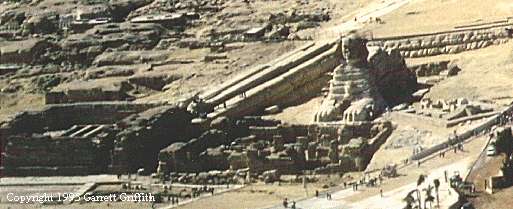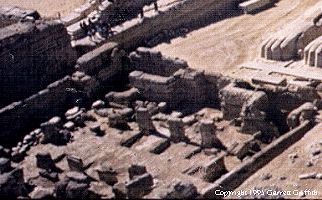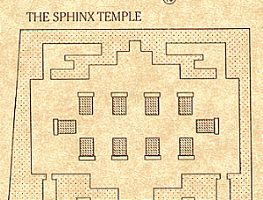|
The Sphinx & Temples

|
FROM ABOVE - Here's an aerial photo of the Sphinx and Temples showing the Sphinx (facing east), the Sphinx Temple just in front, the 'granite lined' Valley Temple (it used to have an open air court on top), the many tombs and offering temples to the south (left), the restored section of the causeway connecting it with the 2nd pyramid, the erosion on the west wall of the Sphinx enclosure, and a restored temple (angled to the Sphinx's left paw).
|
 
More than 4000 years ago, it is believed, masons quarried huge blocks from the limestone bedrock around and in front of the Sphinx. These were used to build what we now call the 'Sphinx Temple' and the 'Valley Temple'. This photo shows the remains of the NE corner of the Sphinx Temple and the north wall of the 'quarry' or enclosure in which the sphinx and the temples are located. The blocks are much more weather eroded than the bedrock wall next to them.
|
|
|
FROM THE EAST-A very awesome place - The Sphinx, the Sphinx Temple, the Granite-Lined Valley Temple, the Causeway connecting it to the second pyramid. These are some of the biggest and oldest structures on earth. No inscriptions have been found on any of them and no record of their construction. Egyptologists believe them to have been built by the 4th Dynasty Pharaoh Khafre.
|
|
The east facing front of the "Granite Lined Valley Temple" with the second pyramid in the background. W.M. Flinders Petrie called it "Granite Lined" because some time after the walls were made of huge (monolithic) limestone blocks, builders added a layer of giant granite blocks inside and out. Notice the two paved walkways extending due east from the two entrances to the temple. Under the left (southern) one is an ancient stone cover plate. Between the walkways, the ancient builders excavated the bedrock several feet lower than the walkways on three sides. |
| This plan diagram from the Guide to the Giza Plateau shows a bird's eye view of the front of the temple pictured above. |
|
|
|
|
This ancient stone coverplate, large enough for a man to fit through, is above a deep vertical shaft of unknown depth or purpose. Water fills this shaft to within a foot of the cover plate. (#17). It is in the bottom of the short underpass (#15) which goes under the walkway extending eastward from the south entrance to the valley temple. |
To the North of the northern walkway (#15) and at the same level as the bedrock, is a layer of huge limestone blocks. Some of these blocks are as big as the blocks in the walls of the nearby temples. In November of 1995, cracks as wide as 1/2 inch were allowing sand to disappear into cavities of unknown depth below the blocks. |
|
This huge block of granite is one of the remaining "lining" stones on the front of the "granite lined" temple. It is over 4' tall and nearly 20' long. Originally the walls of this bulding were nearly forty feet tall. The huge stones behind them are the original core blocks of limestone. There is an ongoing debate about when the limestone blocks were put in place. They appear to be very eroded and may have been assembled earlier than the granite ones. The age debate may be settled when the results of carbon dating research started in 1994 is published. |
Looking up at an alcove above one of the two main entrances to the temple.
It is likely that, originally, there was a statue here.
Index |
Page 1 |
Page 2 |
Page 3
|
|